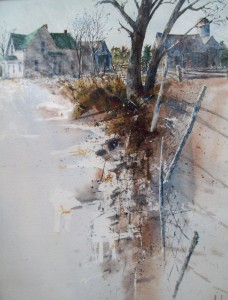No matter what you see in nature. No matter what scene you sketch or photograph. Remember, from the moment you start placing pigment to canvas, board, paper, or whatever surface you use, the finished painting belongs to no one but you; and it always will. Your name is on it forever.
Most of the time, if you’re painting from a photograph, they are bad photographs; that is, unless you are a professional photographer with some very expensive equipment. When I’m talking bad, I’m talking about the accurate colors from nature. This is why it is always best to paint from nature.
Since I do most of my work in a studio, I use both photography and color sketches from nature. When I see a sky that has a certain blue, yellow, gray, pink, or white hue, I try to match it and make swatches of color on a 3X5 index card with notes on the back describing the weather condition, the time of day, and any other thing that creates the mood of the painting. I usually can find a use for the card another day for another painting.
I hardly ever use the color in photography to influence my painting. For anyone that does, then I suggest they study the photograph and analyze the difference between it and nature. I, also, seldom use a photograph to determine my painting. I will use it for reference. I’ll rearrange the objects within the photo to fit my whim, chasing some desired effect, or abstraction, unless the photo convinces me that it depicts the best outcome.

After all is considered, then do the painting your way, your style, and be creative. I made several photographs of The Winter Farm before I decided to tackle this watercolor.
Except for references to the farmhouse and barn in the background, the photos were not used. The tree in the middle ground was from a different photo in a different place. The fence came out of my mind and flushed on down into the foreground.
I used my artistic license to come up with what is shown, but I own it. My name is on it and it will forever be mine.
